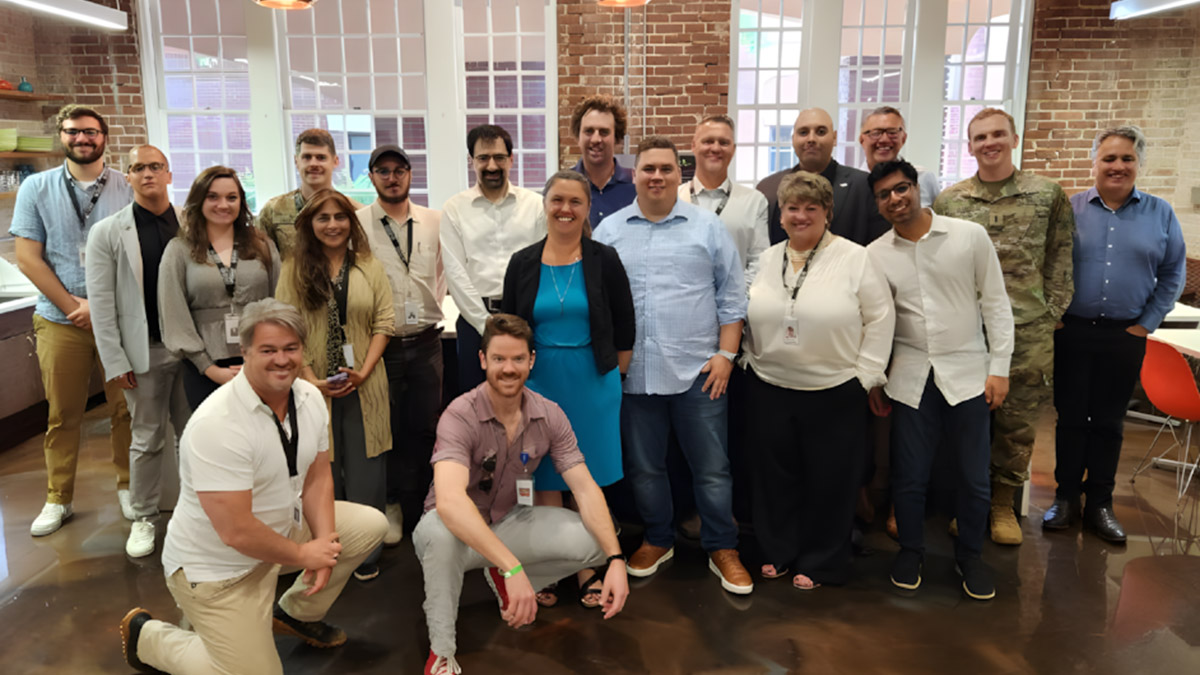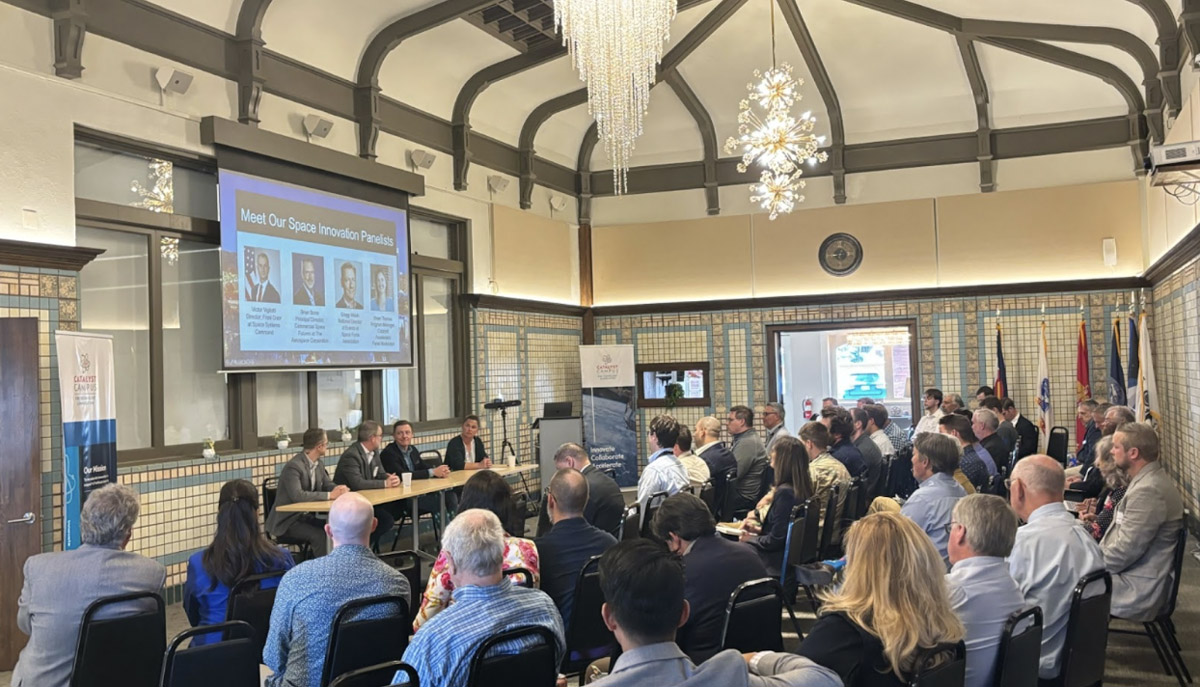 Cohort members, navigators, and industry participants pose for a photo at the Catalyst Accelerator in Colorado Springs. (Source: Catalyst Accelerator Colorado Springs)
Cohort members, navigators, and industry participants pose for a photo at the Catalyst Accelerator in Colorado Springs. (Source: Catalyst Accelerator Colorado Springs)
COLORADO SPRINGS, Colo. – Challenges in the space domain is a pressing issue for the United States military and others, with thousands of satellites scheduled to launch into LEO, debris cluttering satellite orbits, and potential adversarial threats.
At the Catalyst Campus for Technology and Innovation in Colorado Springs, seven start-up companies participated in a Catalyst Accelerator addressing a few of these problems. Over the past three months, they demonstrated creative new solutions to long-standing obstacles in Space Domain Awareness (SDA). The Accelerator focused on software solutions capable of data fusion and processing techniques. Several of the tech solutions pitched by the participating companies addressed SDA issues like limitations in predicting satellite movements, lack of visual awareness in orbit, and repairing dying satellites.
Predicting Satellite Movements with AI
Currently, satellite operators are limited in their abilities to predict long-term satellite movements. Jef Smith, CEO and founder of AI software start-up and Catalyst participant Astra Ultra, credits his interest in this area to his work as a grad student. “I used to work on a Space Force program, and there was a problem where we were only allowed to propagate our orbits out two days in advance, because the accuracy of the orbit propagation was just getting really bad after that,” said Smith. “I was in grad school at the time and decided, oh, well, there’s a problem I can solve using recurrent neural networks.”
Astra Ultra uses predictive analytics for sense-making and data fusion products. In participating with the Accelerator, Astra Ultra sought to further develop Custos, their AI product. “The first version of Custos is designed to detect satellite maneuvers,” said Smith. “[It] classifies them based off of the orbital parameters, saying, hey, this satellite moves X amount in this direction, Y amount in this direction, and then also the time of that maneuver. And the basis of it is a physics informed neural network.” Custos is data agnostic and capable of integrating data from any source, which allows satellite operators to predict satellite positions more accurately over longer time frames.
Satellites Flying Blind
Limited data processing capabilities also means that satellite operators don’t have visual information of satellite movements when they are actually happening. Complex, real-time data processing is an obstacle for many satellite companies looking for better maneuvering and observation abilities in orbit. Bringing video processing tech to orbit would allow satellite operators to monitor the health of spacecraft, conduct refueling and docking procedures, and identifying flying debris or other threats.
AI/ML video processing company TRL11 is bringing high frame rate detection and video from satellites in orbit down to the ground so that satellite operators can actually see what is going on. TRL11 has developed a hardened camera called Fovea that captures everything that is visible from a satellite. Then, Savor, a space aware processor, “intelligently identifies and filters out the vast amounts of unneeded visual information, from the constant movement always present in space,” said Verheem, founder and CEO of TRL11, in a video released after Demo Day.
Savor and Fovea would save up to 90% of the bandwidth needed to send full motion, low delay video to systems on the ground. The ultimate goal is “more valuable visual information using less data,” said Verheem.
Dying Satellites in GEO
Another obstacle in space domain awareness is crowding and aging satellites in orbit—especially satellites in GEO that are difficult to maintain and replace. Accelerator participant iMETALX pitched an innovative new way to tackle this problem: a Rendezvous Proximity and Docking Kit called Willow. Willow allows for precise maneuvers and maintenance, with autonomous docking, repairing, repositioning and refueling capabilities. This stretches the ROI of the original investment while also addressing the problem of cluttering in space and the cost of replacement.
iMETALX has also developed a product called the Optical Fence, which is an agile constellation that will monitor LEO and GEO for debris and threats via space-based sensors pointed away from Earth to detect, track and characterize objects less than ten centimeters, addressing the mounting worries about debris and crowding in LEO.
The company has already received several million dollars in funding. CEO Nehal Gajjar emphasized the support received over the course of the Accelerator in an interview with Program Director KiMar Gartman: “a lot of the community here is aligned with our mission set, which is to help the warfighters,” she said. “We’ve had a number of conversations we would not have had, especially in the span of a few weeks, directly with the warfighters.”
 Catalyst participants listen to a lecture in the final week of the Accelerator as they prepare for Demo Day. (Source: Catalyst Accelerator Colorado Springs)
Catalyst participants listen to a lecture in the final week of the Accelerator as they prepare for Demo Day. (Source: Catalyst Accelerator Colorado Springs)
Accelerator and Demo Day
Other solutions pitched at the Accelerator focused on areas like establishing autonomous control of satellites, advanced monitoring of potential threats, fully digital ground technology, and small ground-based observatories.
Before beginning the Accelerator, each company was required to have relevant technology at a significant stage of development before participating in the Accelerator. “Companies with a TRL of 4-6 are most favorable for the program,” said Shae Thomas, Program Manager, referencing the Technology Readiness Level that indicates the maturity level of a particular technology. “This TRL range allows companies to pivot their R&D, if needed, as they vet their technology against actual challenges according to the government and industry experts we bring into the program.”
Over the course of the Accelerator, the seven participating companies were guided by government navigators and end-user, business experts, and commercial navigators from industry giants like Kratos, Lockheed Martin, Northrup Grumman, Scout Space, and more. Demo Day drew a crowd of 115 personnel, including attendees from the Air Force and Space Force. “The companies leave the program with a more robust understand of the government contracting landscape and who the major players are,” said Thomas.
“The Accelerator tracks each company’s economic impact over three years, post-Accelerator, to see how they are doing,” said Thomas. “Measurements on this impact survey include their investments like contracts and private investment, how many jobs they have created, capital improvements like expansion of manufacturing or office space.”
The Accelerator and Demo Day was fully funded through the Air Force Research Lab Space Vehicles Directorate. The next Accelerator is focused on utilizing commercial capabilities for digital modernization, and will be held in Ogden, Utah in Fall 2024.
Explore More:
Podcast: Being a Disruptor, Spiral Development and Proliferated Tactical Data Networks
Falling Debris and Near-Miss Collisions: Mitigating Risk in LEO
So You Want to be a Space Startup: Regional Initiatives for Entrepreneurs
US Space Force Updating Testing, Simulators for a Contested Domain
